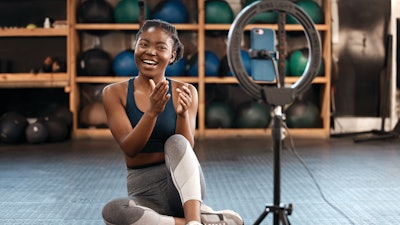
In a TikTok post last November, two female fitness influencers mocked the movements of “the weird man” working out in the corner of the gym, and then doubled over in laughter at their own imitations. Once alerted to the situation, the gym’s manager expelled the duo.
Earlier this year, fitness influencer Joey Swoll, the self-anointed “CEO of gym positivity” boasting 7 million TikTok followers, took to the platform to strike a blow for all the non-influencers who he argues shouldn’t have to alter their route through the fitness floor because some influencer’s camera stand is blocking the walkway.
Social media influencers have permeated nearly every aspect of our lives in recent years, and fitness facilities are no exception. What was once a safe space for personal health and fitness goals has evolved into a public showcase of fitness lifestyles, often at the expense of traditional gym etiquette.
The impact of social media influencers in fitness spaces has created controversies, sparked debates, and even caused some facilities to take drastic measures. The ever-changing dynamics between social media influencers and accepted gym culture demand an exploration of privacy concerns, disruptions to the fitness facility atmosphere, ethical issues, and thoughts and ideas for finding common ground.
1. The evolution of gym culture
The days of gyms as quiet sanctuaries for individuals to work out peacefully are long gone. With the rise of social media, gym spaces have become stages where influencers spotlight their workouts for the whole world to see, blurring the lines between personal and performative fitness.
There are situations every day in almost every fitness facility where influencers, driven by the need to create content and record themselves and others without consent, ignite tensions within gym communities. Picture a busy facility in downtown Los Angeles. It wouldn’t be surprising to witness fitness enthusiasts posing mid-workout to show off for their TikTok followers.
2. Privacy concerns
People’s privacy concerns are at the crux of the debate surrounding influencers in gym spaces. While influencers aim to showcase their fitness journeys to the world, they often disregard the privacy of fellow gym-goers. Many facility members express discomfort at being filmed without their consent, feeling violated in what they think should be a safe and private space. This breach of privacy interferes with the workout experience and raises questions about consent and respect within fitness facility settings.
Consider a regular gym-goer who was surprised and embarrassed when they found themself in the background of a viral fitness video without their consent. This would likely leave that person feeling exposed and uneasy, tarnishing their facility experience. This type of situation will lead members to question the boundaries of privacy in shared fitness spaces, as well as their choice of gym.
3. Impact on gym atmosphere
When social media influencers film their workouts, it often alters the facility’s ambiance and disrupts and distracts other members. Whether it is setting up cameras or smartphones on tripods, monopolizing equipment, or occupying more space than necessary for recording purposes, content creators can alter an environment, making it less conducive to the focused exercise of others. The constant distractions could lead to frustration among facility regulars expecting a different, more familiar experience.
Imagine a scenario where a social media influencer sets up a phone on a tripod on a crowded gym floor to capture the perfect angle of their latest workout for their legions of followers. As they adjust their phone settings, review video clips, and strike more poses, other gym members find themselves dodging the tripod and frustrated by the disruption of their workout.
4. Ethical considerations
Beyond simple privacy concerns and disruptions to the facility atmosphere, there are ethical implications associated with influencers who use their platform to promote products and services within facility spaces. When social media influencers integrate sponsored content into their workout videos, they blur the lines between actual fitness advice and commercial endorsements. This commercialization of facility environments undermines the authenticity of fitness culture and raises questions about the integrity of influencer content and how it may impact impressionable audiences.
To make this tangible, think about an influencer promoting a particular supplement on Instagram without disclosing that they’re being paid to do it. Their followers may view these sponsored content endorsements as genuine recommendations or authentic advice. If this takes place at your facility, it could place the facility in a bad light, as people may assume that the facility supports this sort of promotion regardless of whether it is honest or valid.
5. Finding common ground
Considering these challenges, exploring potential solutions for fostering a harmonious environment in which influencers can create content while respecting the expectations and comfort of fellow exercisers is a must.
Issuing media passes or designating specific filming areas within the facility are potential solutions that could help minimize disruptions and ensure nobody is filmed without permission. Additionally, open communication between influencers, gym management and gym members is essential for establishing mutually agreed-upon guidelines that promote respect and inclusivity in facility spaces.
As social media continues to impact nearly every facet of modern life, the influence of so-called influencers in fitness facilities shows no sign of slowing down. Understanding that means carefully navigating the intersection of social media and traditional facility etiquette, which requires thoughtful consideration and proactive measures.
By considering privacy concerns, minimizing disruptions and upholding your brand’s ethical standards, it’s possible to create a gym environment that is welcoming, respectful and conducive to everyone being free to pursue their health and fitness goals unabated. Through ongoing dialogue and collaboration, the future of fitness facility culture in the age of social media can be shaped and its integrity and inclusivity for generations of fitness-goers preserved.





































